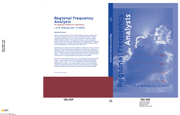Book contents
- Frontmatter
- Contents
- Preface
- Errata
- Chapter 1 Regional frequency analysis
- Chapter 2 L-moments
- Chapter 3 Screening the data
- Chapter 4 Identification of homogeneous regions
- Chapter 5 Choice of a frequency distribution
- Chapter 6 Estimation of the frequency distribution
- Chapter 7 Performance of the regional L-moment algorithm
- Chapter 8 Other topics
- Chapter 9 Examples
- Appendix: L-moments for some specific distributions
- References
- Index of notation
- Author index
- Subject index
Chapter 5 - Choice of a frequency distribution
Published online by Cambridge University Press: 30 October 2009
- Frontmatter
- Contents
- Preface
- Errata
- Chapter 1 Regional frequency analysis
- Chapter 2 L-moments
- Chapter 3 Screening the data
- Chapter 4 Identification of homogeneous regions
- Chapter 5 Choice of a frequency distribution
- Chapter 6 Estimation of the frequency distribution
- Chapter 7 Performance of the regional L-moment algorithm
- Chapter 8 Other topics
- Chapter 9 Examples
- Appendix: L-moments for some specific distributions
- References
- Index of notation
- Author index
- Subject index
Summary
Choosing a distribution for regional frequency analysis
General framework
In regional frequency analysis a single frequency distribution is fitted to data from several sites. In general, the region will be slightly heterogeneous, and there will be no single “true” distribution that applies to each site. The aim is therefore not to identify a “true” distribution but to find a distribution that will yield accurate quantile estimates for each site.
The chosen distribution need not be the distribution that gives the closest approximation to the observed data. Even when a distribution can be found that gives a close fit to the observed data, there is no guarantee that future values will match those of the past, particularly when the data arise from a physical process that can give rise to occasional outlying values far removed from the bulk of the data. As noted in Section 1.2, it is preferable to use a robust approach based on a distribution that will yield reasonably accurate quantile estimates even when the true at-site frequency distributions deviate from the fitted regional frequency distribution.
There may be a particular range of return periods for which quantile estimates are required. In analyses of extreme events such as floods or droughts, quantile estimates in one tail of the distribution will be of particular interest. In other examples, quantiles far into the tails of the distribution may be of little interest. These considerations may affect the choice of regional frequency distribution. If only quantiles in the upper tail are of interest, for example, then it need not matter if a distribution that can take negative values is fitted to data that can only be positive.
- Type
- Chapter
- Information
- Regional Frequency AnalysisAn Approach Based on L-Moments, pp. 73 - 86Publisher: Cambridge University PressPrint publication year: 1997

